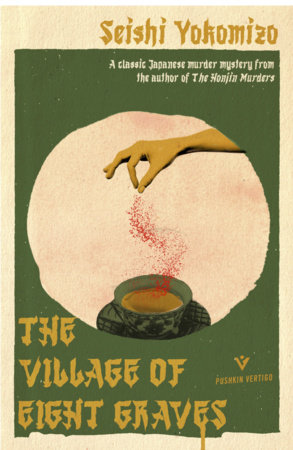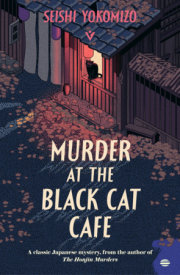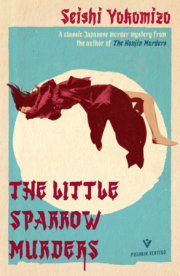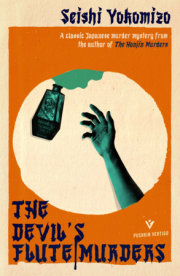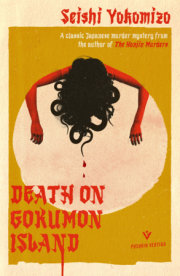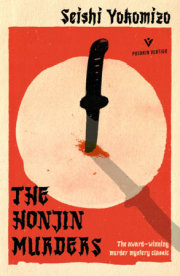PROLOGUE
The village of Eight Graves is perched amid the desolate
mountains on the border of Tottori and Okayama prefectures.
Naturally, arable land is scarce in these parts, and of what little
there is, most is given over to a small handful of rice paddies
dotted around, each measuring only ten or, at most, twenty tsubo,
or about seven hundred square feet. The inhospitable climate
makes for a meagre harvest, and no matter the calls to increase
production, the rice paddies yield barely enough to feed the
villagers. Nevertheless, owing to a wealth of other resources,
the inhabitants there live in relative comfort.
Charcoal-making and cattle-rearing are the main industries
in Eight Graves. The latter is a recent phenomenon, but the
former has been the villagers’ chief livelihood for generations.
The mountains that envelop the village stretch all the way to
Tottori and are blanketed in various species of oak—blue,
sawtooth and jolcham. They grow in such abundance that the
region has long been famed for its charcoal throughout the
whole of Kansai.
In more recent times, however, it is cattle-rearing that has
become the village’s main source of revenue: the local breed, the
chiya-ushi, serves just as well for working as it does for eating,
and the cattle market at neighbouring Niimi attracts traders
from far and wide.
Each household in the village is charged with raising ve or
six head of cattle: they aren’t the property of the village farmers,
but that of the landowners who give the farmers the calves and
sell them on when they are fully grown. The proceeds of the
sale are then shared between the farmer and the landowner
at a xed rate. Thus, as in any agricultural village, the owners
and the sharefarmers are pitted against one another: in such a
modest settlement as this, there are stark dierences in fortune.
In Eight Graves, there are two wealthy houses: the Tajimis
and the Nomuras. Since the Tajimi family is situated in the east
of the village, they are known as “The House of the East”, while,
by the same stroke of reasoning, the Nomura family is known
as “The House of the West”.
But a mystery remains: the origin of the village’s name…
Inured to it across generations, those who have been born
and laid their bones to rest there will scarcely have given a
second thought to this bizarre name. But outsiders will wonder
at hearing it for the rst time. There must be a story there,
they’ll think. And indeed, a story there is—and a strange one.
To tell it, we must go back some 380 years, all the way to the
Age of Warring States…
On 6th July, in the year 1566, when the great daimyo Yoshihisa
Amago yielded to his enemy Motonari Mori and surrendered
the Tsukiyama Castle, one of his young samurai refused to give
himself up and ed the castle with seven faithful retainers.
Legend has it that, in the hope of continuing their struggle
another day, they saddled three horses with 3,000 tael of gold
and, after enduring many hardships, fording rivers and crossing
mountains, nally arrived at this very village.
To begin with, the villagers received the eight warriors hospitably
enough. Put at ease by this reception and the villagers’
simple ways, the warriors decided to stay in the village for a time,
donning peasant clothes and even taking up charcoal-making.
Fortunately, the deep mountain terrain oered plenty of
spots in which to take refuge, should the need ever arise.
Because of limestone deposits throughout the area, there were
caves, which also provided convenient hiding places. There
were a great number of these caves and grottoes down in the
valley, some so deep and labyrinthine that no one had dared
to explore their furthest reaches. If ever you were pursued, you
could easily hide yourself away there. Doubtless it was precisely
this geography that led the eight warriors to decide to make
the village their temporary abode.
Six months passed in peace and harmony, without any trouble
between the villagers and the eight samurai. Meanwhile,
however, Mori’s men had redoubled their eorts, for the leader
of the fugitives was famous even in the Amago clan, and who
knew what terrible calamity might yet come to pass if he were
left alive to ght another day. At last, their search for the eight
men led them to these very mountains.
The villagers sheltering the fugitives gradually began to
fear for their own lives. Not only that, but the glittering reward
oered by Mori’s men was also enough to make them rethink
their hospitality. What tempted the villagers most, however, was
the 3,000 tael of gold that had supposedly been carried on
horseback. If only they could kill the fugitives, every last one of
them, then no one else would ever know about the gold. Even
if Mori’s men did happen to know about it, even if they were
looking for it, all the villagers had to do was insist that they
hadn’t ever heard about it, let alone seen anything of the kind.
There were many discussions about this, but eventually
the day came when, having reached a consensus, the villagers
took the eight samurai by surprise. It happened when the men
were in a hut, burning wood to make charcoal. The villagers
surrounded it and, in order to block the men’s escape, set fire
to dried grass on three sides. The youngest and strongest then
burst into the hut, brandishing bamboo spears and hatchets
ordinarily used for tree-cutting. The era had been plagued by
wars, you see, and had instilled the art of warfare even in the
peasantry.
The samurai were caught o guard. They had trusted the
villagers absolutely and this unprovoked attack came like a
bolt from the blue. There were no weapons in that little hut, of
course, so they had to defend themselves as best they could with
billhooks and axes, but the odds were stacked against them and
it was a losing battle. One fell, then another, and another… until
at last the tragic moment came when all eight of them lay slain.
The villagers decapitated every one of the bodies and, with
cries of triumph, set re to the hut: but according to legend,
those eight severed heads wore an expression of such tremendous
reproach that it made anyone who saw them shudder in
fear. The leader of the eight samurai above all retained the terrifying
look he had worn as he lay there dying, hacked to pieces
by the villagers and drowning in his own blood; with his last
breath, he had cursed the village, vowing to visit his vengeance
upon it for seven generations to come.
Although the heads secured for the villagers the promised
bounty from the Mori clan, they were never able to nd where
the all-important 3,000 tael of gold had been hidden. They
hunted for it high and low, in a frenzy, uprooting grass, boring
through sheer rock, tearing up the valley, but never did they nd
so much as a speck of gold. Worse still, during their searches, a
series of ominous events occurred: one man met his tragic end,
trapped by a cave-in in the depths of a grotto; another, while
drilling the rock face, caused a landslide and lost his footing,
falling to the bottom of a ravine, leaving him lame for the rest
of his days; and a third man, who was digging the earth at the
roots of a tree, was horribly crushed under the weight of the
trunk that suddenly collapsed on top of him.
Mysterious happenings such as these followed one after
another, but what came next plunged the villagers into an
abyss of terror.
Six months had passed since the massacre of the eight
samurai. Who can say why, but that year there were a great
many thunderstorms in the region, bringing with them terrible
bolts of lightning: frightened, the villagers saw in this a sign of
the eight warriors’ curse. One day, the lightning struck a cedar
in the garden of Shozaemon Tajimi, splitting the great tree in
two with tremendous force, right down to its very roots. Now,
the curious thing was that this Shozaemon Tajimi had been the
ringleader of the attack on the warriors, and, since that day, he
had been plagued by remorse and had begun to act strangely,
tyrannizing his family and doing things that nobody in his
right mind would do. Then the lightning struck the tree… He
seized a sword lying nearby and struck dead several members
of his own household. Then, running out into the street, one
by one he felled every villager he came across, before nally
taking refuge in the mountains, where he ended his life by
self-decapitation.
All in all, there were more than a dozen wounded, but exactly
seven had died by Shozaemon’s hand. Counting Shozaemon
himself, that made a grand total of eight deaths, which, rightly
or wrongly, the villagers fearfully interpreted as another act of
retribution from those eight warriors who had been murdered
in cold blood.
In order to appease their fury, the villagers decided to disinter
the bodies of the eight samurai, whom they had buried
like dogs, and to reinter them with all due ceremony, erecting
eight graves where they were venerated as divinities. Of course,
it was this shrine in the hills behind the village that lent the
place its current name.
Copyright © 2021 by Seishi Yokomizo. All rights reserved. No part of this excerpt may be reproduced or reprinted without permission in writing from the publisher.

